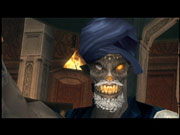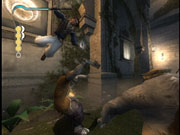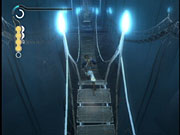No previous experience with the Prince of Persia series is required to enjoy Prince of Persia: The Sands of Time. In fact, virtually nothing will bar you from being impressed by this extremely well-put-together action adventure game from the studio that brought you Splinter Cell and Rainbow Six 3. In stark contrast to Ubisoft Montreal's previous offerings, Prince of Persia is surprisingly easy, despite the incredible acts of skill and daring that the game's main character will routinely perform during the course of the game. As a result, this original, visually stunning game can be highly recommended to just about anyone.

Prince of Persia: The Sands of Time takes place in a mystical Middle Eastern setting, all bathed in soft, warm light and looking like something straight out of a storybook. You play as a young prince who possesses exceptional athletic and acrobatic skill. Early on in the game, the prince steals the dagger of time, a treasure from a rival nation, as a token for his father the king. When his nation's traitorous vizier compels the prince to use the dagger to unlock another treasure, a huge hourglass, everything goes wrong. The sands from the hourglass blow forth, enveloping the kingdom and turning its guardsmen and citizens into, for lack of a better way to describe it, "sand zombies." The prince, the vizier, and a young woman named Farah are among the only survivors. In the prince's efforts to undo his mistake, he'll join forces with Farah, seek out the hourglass, and confront the vizier. The game's story takes a backseat during most of the game, but it is bookended nicely and is framed as the prince's own retrospection. So, for instance, should the prince fall and die at a certain point during the game, you'll hear him say, as narrator, something like, "No, that's not how it happened." Not only is this an interesting technique, but it compels you to keep pressing on. You'll want to know exactly how his complicated ordeal will unravel.
The prince's new dagger of time has other uses besides causing calamity. It's the key to defeating the evil spread throughout the palace, and it also makes the prince virtually immortal. In most cases, should the prince fall to his death or be slain by a sand creature or a trap, with his last breath, he may use the dagger to "rewind" the course of time to a point prior to the unfortunate incident that would have ended his life. Each time you use this ability, it costs a "sand tank," which you earn a greater quantity of as you get farther into the game, and which you restore by defeating sand creatures. In practice, you won't often run out of sand tanks, but even if you do, you'll restart the prince's story from a recent location.

A highly responsive, very forgiving control scheme further ensures that at no point during Prince of Persia: The Sands of Time will you get particularly stuck, if at all. Though other action adventure games involving a lot of death-defying leaps and other such bravery tend to force the player to perfectly time his or her maneuvers and often force him or her to wrestle with issues concerning the controls or camera perspective, Prince of Persia is set up in such a way that it's remarkably simple to pull off all of the prince's spectacular moves. Also, despite the convincing look of the game's huge environments, the game is completely linear, and the prince's course tends to be very clear. Doors will slam shut behind him, forcing him to press onward, and each time you enter a new area, you'll see a quick fly-through showing where it is you're trying to go and what it is that stands between you and that goal. Additionally, at each of the game's frequent save points, you'll see a "vision" of what lies ahead--a quick sepia-toned montage of the trials and tribulations to come in the next area. You'll soon discover that this is basically a built-in hint system. Should you ever get stuck, just head back to a save point, watch the "vision" again, and you'll probably figure out what you're supposed to be doing.
The prince has a great variety of really impressive moves at his disposal. Like a Mid-Eastern Spider-Man, he can defy gravity to a certain extent, by triangle-jumping from wall to wall, running horizontally along vertical surfaces, balancing on narrow ledges, swinging wildly from ropes or horizontal bars, jumping from pillar to pillar, and more. He's truly the most acrobatic character in a game, to date, and executing his moves is simple and even intuitive. The prince can't be made to accidentally fall; he'll automatically grab the ledge if you walk him off of one, and you can hang on indefinitely. A separate button is used for pulling yourself up as opposed to letting go, so there's no worry of accidentally dropping even when you seem to be hanging on for dear life. And, even when you're balancing on a narrow rail thousands of feet above the ground, should you lose your balance and tip over, you'll always catch the ledge and can pull yourself right back up. All this is maybe a little too convenient, but at least it means you'll be forging ahead rather than constantly tumbling into pits.
The gameplay boils down to two things: observation and timing. First you must figure out where it is you're trying to go, which tends to be evident from the area fly-throughs, the "visions," and the occasional markings seen in the levels that point out switches to be flipped or buttons to be pressed. Then you must get there by running along walls, avoiding traps, leaping across chasms, and more. The timing isn't difficult--there's noticeable room for error--and hitting the "jump" button at around the right time, either to roll underneath a trap or to jump at more or less the right moment, will usually do the trick.

The coolest thing about the prince's repertoire of moves is how quickly he can link them together and how nimbly he moves about, in general. The interactions between the prince and the environment are extremely convincing and really must be seen to be fully appreciated. Great, little details are everywhere. If you're standing knee-deep in water and try to run up a wall, you'll see (and hear) the prince's wet feet slip as he fails the move. If you leap straight into a wall, you'll see the prince push himself off and fall back down. Despite his superhuman balance and agility, the prince somehow comes off looking incredibly lifelike and realistic, which makes the gameplay seem all the more approachable. All the prince's moves seem logical in the context of the game, and even early on you'll learn how to tie all these techniques together. For instance, you'll have a chance to launch yourself to the other side of a wall while running across it at early stages of the game. Of further note, special commendation goes to the prince for being the fastest ladder-climber in the history of games. It's a pleasure to just maneuver this character around, which is good, since that's mostly what you'll be doing.
The gameplay in Prince of Persia largely consists of three types of actions: navigation (the most common and best type), combat, and puzzle-solving. The puzzle-solving is straightforward and typical of what you'd find in other action adventure games. You'll push some boxes onto pressure plates, figure out how to use some mysterious machines, pull some switches and levers, and that sort of thing. What makes the puzzles here, at least, seem more interesting is the presence of Farah, the prince's female counterpart, who will automatically assist with some of the puzzles and make them seem like more of a cooperative affair. Farah, who's even skinnier than the prince, can slip through cracks in the wall to reach places the prince cannot. The pair will frequently have to find ways of opening up passages for one another. This pseudo-two-player dynamic, and, in fact, the whole look of the game, is reminiscent of the artistic 2001 PlayStation 2 title, ICO.

One of the key differences is, unlike the female character in ICO, Prince of Persia's Farah isn't a complete liability in battle. Armed with a bow and arrows, she'll help you pick off the droves of sand creatures that you'll occasionally encounter. Just be sure to stay out of her way. Make no mistake, though, the prince will still do most of the work when confronted by enemies. The combat in Prince of Persia, like virtually everything about the game, looks extremely cool. And, like other aspects of the game, it's quite easy. Unfortunately, it's also a little shallow.
Technically, the prince has a wide variety of combat moves. His scimitar will do most of the talking, while the dagger of time is used mostly for finishers. The prince can use his blades to deflect his opponents' attacks and can then quickly counter either with the scimitar or dagger. There's no lock-on targeting system, but just by pressing the analog stick in the direction of an opponent, the prince will automatically attack that target. You can use this to effectively battle groups of enemies, which will have the prince dancing and somersaulting around while kicking and slashing at all nearby foes, like a kung fu action hero. He can also stab his enemies with the dagger to freeze them in place, setting them up for a cool-looking finishing move. Better yet, the prince can vault over enemies, slashing them on his way down. Additionally, he can leap off of walls to execute deadly diving attacks, or he can surprise enemies with turnaround flips from walls. Meanwhile, his enemies will mostly just stand there, looking mean. And that's the main problem. There's a decent variety of enemies, and they have a great look to them, but they're not much of a challenge. Even if they manage to hurt you, the dagger's rewind power can negate the damage, as can any pool of water in the vicinity (of which there is usually one), as drinking water is how you recover your health in Prince of Persia.
Your enemies are slow enough to allow you to drink your fill without much worry. They'll teleport in close to you and crowd you, but they attack slowly and rarely, and most are very vulnerable to vaulting attacks or off-the-wall attacks. Some tougher opponents will bat you aside if you try to vault over them, so the off-the-wall attack becomes the main viable option, effectively limiting the variety. And, as the game wears on, you'll fight larger and larger packs of foes, so the combat will get pretty repetitive before the game is done. Late in the game, you'll acquire a sword that obliterates any sand creatures it touches, and, by then, it makes for a very refreshing change of pace from the rather drawn-out fight sequences that have come before. Nevertheless, it's worth reiterating that, like all other aspects of the game, combat in Prince of Persia controls very well and looks terrific.

Another issue with the game, in addition to the combat and the relative lack of difficulty, is suggested by that special late-game sword. It's basically the only new trick of any real value that you get during the course of the game. While you earn a longer health bar and more special ability slots for your dagger as you get farther into the game, you will have seen essentially all of what the gameplay of Prince of Persia has to offer in the first couple hours of play. A couple of elements--the tightrope walking and the rope swinging--are saved for later, but the game doesn't really give a clear sense of character advancement or heightened challenge as the action carries on. In fact, you probably won't even realize when you're in the middle of the game's climactic battle against the sand creatures as it's pretty much the same as the last few fights you'll have fought.
Prince of Persia is still a pleasure to play through--for the 10-or-so hours it takes to get to the finish line--largely because of the game's extraordinary look. The character models for the prince and Farah actually don't look great, but the rest of the game most certainly does. You'll quickly notice a very slick motion-blur effect that's used when the camera suddenly changes direction--in other games, these types of perspective shifts are typically annoying rather than stylish. Other details abound, such as how sand and dust kicks up from the prince's feet wherever he goes. But the highlight is, of course, the animation. The prince looks like he wouldn't have been out of place in the movie Crouching Tiger, Hidden Dragon, with his incredibly agile and graceful moves, so the Middle Eastern setting combined with the Hong Kong-style action gives Prince of Persia: The Sands of Time a truly unique look. The environments and soft ambient lighting effects used throughout the game are also fantastic-looking, especially on the Xbox, where the colors are richer, the frame rate is smoother, and the resolution is sharper than on the PlayStation 2 or GameCube versions. These versions of the game control equally as well as the Xbox version and look superb in their own rights, but the Xbox version of the game is hands down better.

Excellent audio rounds out this altogether impressive game. The actor who provides the prince's voice fits the role perfectly, creating a likable yet brash personality for the character that's the perfect foil to Farah's cool-headed determination. The banter exchanged between the two characters can be very amusing, and though the two really don't have time for their relationship to develop, it's still plausible that one does. The ambient sounds in Prince of Persia, from the sound of the prince's footsteps on various surfaces to the rush of wind when he's outdoors, are also completely believable. One fairly clever puzzle late in the game completely depends on your ability to hear the game's clear, realistic audio. An excellent musical score, which combines traditional Middle Eastern sounds and instrumentation with a hard rock edge and some nice chorus vocals, also fits the game extremely well. There's just one problem: For the most part, you only hear the music during battle. It's possible that the fast-paced themes would have been conducive to recklessness during the game's running and jumping sequences, but it's a bit of a shame that such a good soundtrack is only heard on relatively rare occasion during the game.
Prince of Persia offers some bonuses, in addition to the main adventure, most notably with the presence of an unlockable port of the original version of the game that started it all. The original Prince of Persia influenced games like Tomb Raider--and pretty much every other game in which you can grab on to ledges--and presents a stark contrast with the new installment in the series in just how punishing it is. On the other hand, Prince of Persia: The Sands of Time is a game that can be recommended wholeheartedly. It looks fantastic and features responsive controls, some original play mechanics, a good story, and plenty of thrilling adventure. In the simplest terms: Do not miss out on this game.